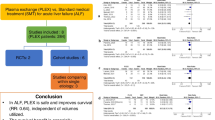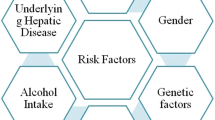Abstract
Objective
The aim of this study was to (a) quantify the gene expression of some cytochromes P 450 (CYP), especially CYP3A4, in serial biopsies from liver grafts the first year after orthoptic liver transplantation (OLT) and (b) study the relationship between hepatic CYP3A4 gene expression and plasma levels of cyclosporine and tacrolimus.
Methods
Liver tissue was obtained from surplus material of routine liver biopsies performed in 20 patients during the first year after OLT. Real-time reverse-transcription polymerase chain reaction was used for quantitative analyses of mRNA specific for CYP3A4, CYP3A5, CYP2E1 and CYP1A2 cytochromes as well as P-glycoprotein (P-gp). The gene expression of β-actin was used as an internal standard for comparisons between samples.
Results
The median value of the mRNA for all cytochromes, but not for P-gp, was found to increase significantly over time. The gene expression of CYP3A5, CYP2E1 and CYP1A2 was higher than that of CYP3A4. The gene expression of CYP3A4 was related to the plasma concentration of cyclosporine and tacrolimus, i.e. low mRNA concentrations corresponded to high serum concentration levels and vice versa. The serum concentration of bilirubin or the prothrombin index did not correlate with the gene expression level of the cytochromes.
Conclusion
The hepatic mRNA expression of CYP3A4 and the other investigated cytochromes increased during the first year after OLT. This was not the case with P-gp. Low CYP3A4 gene expression was related to high plasma levels of cyclosporine and tacrolimus and vice versa.


Similar content being viewed by others
References
Gonzales FJ (1990) Molecular genetics of the P 450 superfamily. Pharmacol Ther 45:1–38
Nelson DR, Koymans L, Kamataki T, Stegeman JJ, Feyereisen R, Waxman DJ, Waterman MR, Gotoh O, Coon MJ, Estabrook RW, Gunsalus IC, Nebert DW (1996) P 450 superfamily: update on new sequences, gene mapping, accession numbers and nomenclature. Pharmacogenetics 6:1–42
Guengerich FP (1989) Polymorphism of cytochrome P 450 in humans. Trends Pharmacol Sci 10:107–109
Wrighton SA, Vandenbranden M and Ring BJ (1996) The human drug metabolising cytochromes P 450. J Pharmacokinet Biopharm 24:461–473
Ueda K, Cornwell MM, Pastan I, Roninson IB, Ling V, Riordan JR (1986) The mdr1 gene, responsible for multidrug-resistance, codes for P-glycoprotein. Biochem Biophys Res Commun 141:956–962
Watkins PB (1997) The barrier function of CYP3A4 and P-glycoprotein in the small bowel. Adv Drug Delivery Rev 27:161–170
Saeki T, Ueda K, Tanigawara Y, Hori R, Komano T (1993) Human P-glycoprotein transports cyclosporine A and FK 506. J Biol Chem 268:6077–6080
Lo A, Burckkart GJ (1999) P-glycoprotein and drug therapy in organ transplantation. J Clin Pharmacol 39:995–1005
Wacher VJ, Wu CY, Benet LZ (1995) Overlapping substrate specificity and tissue distribution of cytochrome P 450 3A and P-glycoprotein: implications for drug delivery and activity in cancer chemotherapy. Mol Carcinog 13:129–134
Baron JM, Goh LB, Yao D, Wolf CR and Friedberg T (2001) Modulation of CYP3A4-dependent metabolism by P-glycoprotein: implications for P 450 phenotyping. J Pharmacol Exp Ther 296:351–358
Willingham MC, Cornwell MM, Cardarelli CO, Gottesman MM, Pastan I (1986) Single cell analysis of daunomycin uptake and efflux in multidrug-resistant and -sensitive KB cells: effects of verapamil and other drugs. Cancer Res 46:5941–5946
Thiebaut F, Tsuruo T, Hamada H, Gottesman MM, Pastan I, Willingham MC (1987) Cellular localisation of the multidrug-resistance gene product P-glycoprotein in normal human tissues. Proc Natl Acad Sci U S A 84:7735–7738
Greiner B, Eichelbaum M, Fritz P, Kreichgauer H-P, Von Richter O, Zundler J, Kroemer HK (1999) The role of intestinal P-glycoprotein in the interaction of digoxin and rifampin. J Clin Invest 104:147–153
Guengerich FP (1999) Cytochrome P 450 3A4: Regulation and role in drug metabolism. Annu Rev Pharmacol Toxicol 39:1–17
Karanam BV, Vincent SH, Lee Chiu SH (1994) FK 506 metabolism in human liver microsomes: investigation of the involvement of cytochrome P 450 isoenzymes other than CYP 3A4. Drug Metab Dispos 22:811–813
Lemaire M, Fahr A and Maurer G (1990) Pharmacokinetics of cyclosporine: inter and intra-individual variations and metabolic pathways. Transplant Proc 22:1110–1112
Armstrong VW, Oellerich M (2000) New developments in the immunosuppressive drug monitoring of cyclosporine, tacrolimus, and azathioprine. Clin Biochem 34:9–16
Jain AB, Abu-Elmagd K, Abdallah H, Warty V, Fung J, Todo S, Starzl TE, Venkataramanan R (1993) Pharmacokinetics of FK506 in liver transplants recipients after continuous intravenous infusion. J Clin Pharmacol 33:606–611
Fukatsu S, Yano I, Igarishi T, Hashida T, Takayanagi K, Saito H, Uemoto S, Kiuchi T, Tanaka K, Inui K (2001) Population pharmacokinetics of tacrolimus in adult recipients receiving living-donor liver transplantation. Eur J Clin Pharmacol 57:479–484
Levy GA (1999) Relationship of pharmacokinetics to clinical outcomes. Transplant Proc 31:1654–1658
Wieland E, Shipkova M, Schütz E, Braun F, Niedmann P-D, Armstrong V, Ringe B, Svinarov D, Oellerich M (2001) Preliminary report on the effect of xenoperfusion with human blood on cyclosporine A metabolism and cytochrome-P 450 3A4-mRNA expression in a pig liver perfusion model. Clin Biochem 34:53–57
Tamura Y, Imaoka S, Gemba M, Funae Y (1997) Effects of ischemia-reperfusion on individual cytochrome P 450 isoforms in the rat kidney. Life Sci 60:143–149
Wu C-Y, Benet LZ, Hebert MF, Gupta SK, Rowland M, Gomez DY, Wacher VJ (1995) Differentiation of absorption and first-pass gut and hepatic metabolism in humans: studies with cyclosporine. Clin Pharmacol Ther 58:492–497
Lown KS, Mayo RR, Leichtman AB, Hsaio H, Turgeon K, Schmiedlin-Ren P, Brown MB, Guo W, Rossi SJ, Benet LZ, Watkins PB (1997) Role of intestinal P-glycoprotein (mdr1) in interpatient variation in the oral bioavailability of cyclosporine. Clin Pharmacol Ther 62:248–260
Sumida A, Kinoshita K, Fukada T, Matsuda H, Yamamoto I, Inaba T, Azuma J (1999) Relationship between mRNA levels quantified by reverse transcription-competitive PCR and metabolic activity of CYP3A4 and CYP2E1 in human liver. Biochem Biophys Res Commun 262:499–503
Rodrigez-Antona C, Donato MT, Pareja E, Gómez-Léchon M-J and Castell JV (2001) Cytochrome P 450 mRNA expression in human liver and its relationship with enzyme activity. Arch Biochem Biophys 393:308–315
Kalayoglu M, Sollinger HW, Stratta RJ, D’Allesandro AM, Hoffman RM, Pirsch JD, Belzer FO (1988) Extended preservation of the liver for clinical transplantation. Lancet 19:617–619
Chomczynski P, Sacchi N (1987) Single-step method of RNA isolation by acid guanidinium thiocyanate-phenol-chloroform extraction. Anal Biochem 162:156–159
Finnström N, Thörn M, Lööf L, Rane A (2001) Independent patterns of cytochrome P 450 gene expression in liver and blood in patients with suspected liver disease. Eur J Clin Pharmacol 57:403–409
Öhrvik J (2002) Nonparametric methods in the two-way layout. Chiang Mai J Sci 29:103–115
Toussaint R-M, Coomes M (1993) Role of cytochrome P 450 in modulating cyclosporine levels in transplant patients. Transplant Proc 25:1980–1982
Pichard L Fabre I, Domergue J, Joyeux H, Maurel P (1991) Effect of FK-506 on human hepatic cytochromes P 450: interactions with Cya. Transplant Proc 23:2791–2793
Kuehl P, Zhang J, Lin Y, Lamba J, Assem M, Schuetz J, Watkins PB, Daly A, Wrighton SA, Hall SD, Maurel P, Relling M, Brimer C, Yasuda K, Venkataramanan R, Strom S, Thummel K, Boguski MS, Schuetz E (2001) Sequence diversity in CYP3A promoters and characterization of the genetic basis of polymorphic CYP3A5 expression. Nat Genet 27:383–391
Jounaïdi Y, Hyrailles V, Gervot L and Maurel P (1996) Detection of a CYP3A5 allelic variant: a candidate for the polymorphic expression of the protein. Biochem Biophys Res Commun 221:466–470
Ayoma T, Yamano S, Waxman DJ, Lapenson DP, Meyer UA, Fischer V, Tyndale R, Inaba T, Kalow W, Gelboin HV, Gonzalez FJ (1989) Cytochrome P 450 hPCN3, a novel cytochrome P 450 IIIA product that is differentially expressed in adult human liver. J Biol Chem 264:10388–10395
Wrighton SA, Ring BJ, Watkins PB, Vandenbranden M (1989) Identification of a polymorphically expressed member of the human cytochrome P 450 III family. Mol Pharmacol 36:97–105
Wrighton SA, Stevens JC (1992) The human hepatic cytochromes P 450 involved in drug metabolism. Crit Rev Toxicol 22:1–21
Wrigthon SA, Brian WR, Sari M-A, Iwasaki M, Guengerich FP, Raucy JL, Molowa DT, Vandenbranden M (1990) Studies on the expression and metabolic capabilities of human liver cytochrome P 450 IIIA5 (HLp3). Mol Pharmacol 38:207–213
Bowen WP, Carey JE, Miah A, McMurray HF, Munday PW, James RS, Coleman RA, Brown AM (2000) Measurement of cytochrome P 450 gene induction in human hepatocytes using quantitative real-time reverse transcriptase-polymerase chain reaction. Drug Metab Dispos 28:781–788
Koch I, Weil R, Wolbold R, Brockmöller J, Hustert E, Burk O, Nuessler A, Neuhaus P, Eichelbaum M, Zanger U, Wojnowski L (2002) Interindividual variability and tissue-specificity in the expression of cytochrome P 450 mRNA. Drug Metab Dispos 30:1108–1114
Rodrigez-Antona C, Jover R, Gómez-Léchon M-J, Castell JV (2000) Quantitative RT-PCR measurement of human cytochrome P 450s: application to drug induction studies. Arch Biochem Biophys 376:109–116
Bader A, Hansen T, Kirchner G, Allmeling C, Haverich A, Borlak JT (2000) Primary porcine and hepatocyte cultures to study drug oxidation reactions. Br J Pharmacol 129:331–342
Finnström N, Bjelfman C, Thörn M, Lööf L and Rane A (1999) Quantification of cytochrome P 450 mRNAs in patients with suspected liver diseases as assessed by reverse transcriptase-PCR. J Lab Clin Med 134:134–140
Andersen MR, Farin F, Omiecinski CJ (1998) Quantification of multiple human cytochrome P 450 mRNA molecules using competitive reverse transcriptase-PCR. DNA Cell Biol 17:231–238
Sy S, Ciaccia A, Li W, Roberts E, Okey A, Kalow W, Tang B-K (2002) Modeling of human hepatic CYP3A4 enzyme kinetics, protein and mRNA indicates deviation from log-normal distribution in CYP3A4 gene expression. Eur J Clin Pharmacol 58:357–365
Acknowledgements
We thank Mrs. Charlotte Thyr for important laboratory work with mRNA that paved the way for setting up the present methodology. We also thank Niklas Finnström, Ph.D., and Dr. Roberto Canaparo for preparing some of the standards and probes, Dr. Lisbeth Barkholt for help with collecting liver samples, all surgeons and personnel at the transplantation unit HSAS for collecting the samples during operations and research nurses Ingrid Skarp-Öberg, Maria Sveneus-Lundgren, Thomas Johansson and Aina Östman for helping in the collection of patient data. We also thank John Öhrvik, Ph.D., for excellent statistical guidance and Associate Professor Cristina Rodriguez-Antona for comparative analyses. This work was supported by the Swedish Science Council (04496), Swedish Cancer Society, the Mary Eriksson foundation, the foundation for undergraduate researchers at Uppsala University and grants from the research foundation, county of Västmanland. This study complies with the current law in Sweden.
Author information
Authors and Affiliations
Corresponding author
Rights and permissions
About this article
Cite this article
Thörn, M., Lundgren, S., Herlenius, G. et al. Gene expression of cytochromes P 450 in liver transplants over time. Eur J Clin Pharmacol 60, 413–420 (2004). https://doi.org/10.1007/s00228-004-0786-4
Received:
Accepted:
Published:
Issue Date:
DOI: https://doi.org/10.1007/s00228-004-0786-4




